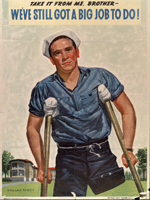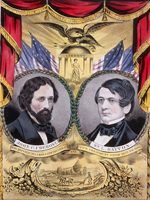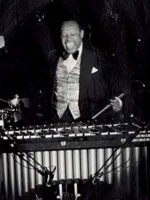1. The earliest-known board game printed and invented in the U.S. was designed to teach:
a. U.S. geography
b. European history
c. Proper moral behavior
d. Multiplication tables
 In 1822, the New York publishers F&R Lockwood published The Traveller's Tour through the United States, the first board game developed and printed in the U.S. Players moved their pieces along a set path around a map of the U.S., stopping at numbered points in the 24 states and four territories that made up the country at the time. At each point, players tried to name the city the point represents; if they failed, they lost a turn and had to try again in the next round. According to historian Daniel Kilbride, the game presents a genteel, nationalistic view of the country to accompany its geography lesson—the manual describes the U.S. as "by far the finest portion of the western continent . . . with respect to wealth, fertility, civilization, and refinement."
In 1822, the New York publishers F&R Lockwood published The Traveller's Tour through the United States, the first board game developed and printed in the U.S. Players moved their pieces along a set path around a map of the U.S., stopping at numbered points in the 24 states and four territories that made up the country at the time. At each point, players tried to name the city the point represents; if they failed, they lost a turn and had to try again in the next round. According to historian Daniel Kilbride, the game presents a genteel, nationalistic view of the country to accompany its geography lesson—the manual describes the U.S. as "by far the finest portion of the western continent . . . with respect to wealth, fertility, civilization, and refinement."
2. Late 19th-century board games promoted the "rags to riches" myth of American success. Titles included:
a. Paul Pennywise's Game of Common-sense
b. Game of the District Messenger Boy, or Merit Rewarded
c. Rags to Riches
d. Golden Shores, The Immigrant's Story
 The Game of the District Messenger Boy, or Merit Rewarded, published by McLoughlin Brothers in 1886, represented a trend in board games at the time—and popular culture and American myth in general. In the game, players compete to be the first to climb from lowly telegraph courier to president of a telegraph company. Spaces give the player rewards for qualities like "intelligence" and "promptness" and punishments for "drowsiness" and "impertinence"—"theft" requires a player to go to jail and restart from the beginning. Similar games included The Game of the Telegraph Boy (1888), The Errand Boy (1891), and Cash: Honesty is the Best Policy (1890) .
The Game of the District Messenger Boy, or Merit Rewarded, published by McLoughlin Brothers in 1886, represented a trend in board games at the time—and popular culture and American myth in general. In the game, players compete to be the first to climb from lowly telegraph courier to president of a telegraph company. Spaces give the player rewards for qualities like "intelligence" and "promptness" and punishments for "drowsiness" and "impertinence"—"theft" requires a player to go to jail and restart from the beginning. Similar games included The Game of the Telegraph Boy (1888), The Errand Boy (1891), and Cash: Honesty is the Best Policy (1890) .
3. The Game of Life (or LIFE, published in its modern form in 1960), in which players progress through the stages of a stereotypical successful American life to reach retirement, developed from an earlier game, published in:
a. 1823
b. 1860
c. 1920
d. 1945
 In 1860, American board game inventor Milton Bradley created and published The Checkered Game of Life, in which players raced to travel from "Infancy" to "Happy Old Age." Along the way, they might get married, fall into poverty, attend college, go into politics, or suffer from character flaws including "intemperance" or "idleness." The game promotes personal merits like "honesty," "ambition," "industry," and "bravery"—showing a shift away from the spiritual virtues promoted by earlier board games and towards the mythology of the American rise to success crystallized in later games (such as The Game of the District Messenger Boy).
In 1860, American board game inventor Milton Bradley created and published The Checkered Game of Life, in which players raced to travel from "Infancy" to "Happy Old Age." Along the way, they might get married, fall into poverty, attend college, go into politics, or suffer from character flaws including "intemperance" or "idleness." The game promotes personal merits like "honesty," "ambition," "industry," and "bravery"—showing a shift away from the spiritual virtues promoted by earlier board games and towards the mythology of the American rise to success crystallized in later games (such as The Game of the District Messenger Boy).
A financial success (during the Civil War, charitable organizations purchased thousands of copies of the game and distributed them to soldiers), the game resurfaced in various forms over the next century. In 1959, the Milton Bradley company commissioned toy inventor Reuben Klamer to develop a 100th-anniversary game. Klamer found a board for The Checkered Game of Life in the company archives, and designed his own Game of Life, published in 1960, based loosely on the concept.
4. The inventor of The Landlord's Game, a 1904 precursor to Monopoly, intended the game to highlight:
a. The virtues of capitalism
b. The importance of planning ahead
c. The dangers of capitalism
d. The spread of railroads and new utilities
 In 1904, Elizabeth "Lizzie" Magie received a patent for The Landlord's Game, a board game very similar to Monopoly in its mechanics and appearance, but contrary to the uncritically pro-capitalism game in sentiment. Magie supported the philosophy of economist Henry George (1839-1897), who believed that taxation on any property or asset but land was unfair and called for a single-tax system. The Landlord's Game illustrated the harshness of a multiple-tax system through its play, and was designed to be played a second time through with only land tax penalties, to contrast the two systems.
In 1904, Elizabeth "Lizzie" Magie received a patent for The Landlord's Game, a board game very similar to Monopoly in its mechanics and appearance, but contrary to the uncritically pro-capitalism game in sentiment. Magie supported the philosophy of economist Henry George (1839-1897), who believed that taxation on any property or asset but land was unfair and called for a single-tax system. The Landlord's Game illustrated the harshness of a multiple-tax system through its play, and was designed to be played a second time through with only land tax penalties, to contrast the two systems.
The game influenced other game makers, including salesman Charles Darrow, who developed Monopoly in the 1930s and sold the rights to Parker Brothers. Parker Brothers would later purchase the patent to The Landlord's Game, seeking to reduce competition and exercise exclusive control over Monopoly-like games.



 John Adams, from Abigail Adams (pictured). Abigail Adams wrote this to her husband in a December 23, 1782 letter. The original letter can be read
John Adams, from Abigail Adams (pictured). Abigail Adams wrote this to her husband in a December 23, 1782 letter. The original letter can be read  Woodrow Wilson, to Edith Bolling Galt (pictured). This is from a letter that widower President Wilson wrote from the White House on September 19, 1915, to Edith Bolling Galt, whom he would marry. The full text of the letter is in volume 34 of The Papers of Woodrow Wilson, ed. Arthur Stanley Link (Princeton, NJ: Princeton University Press, 1994), page 491.
Woodrow Wilson, to Edith Bolling Galt (pictured). This is from a letter that widower President Wilson wrote from the White House on September 19, 1915, to Edith Bolling Galt, whom he would marry. The full text of the letter is in volume 34 of The Papers of Woodrow Wilson, ed. Arthur Stanley Link (Princeton, NJ: Princeton University Press, 1994), page 491. Ronald Reagan, to Nancy Reagan (pictured). This is from a letter written on White House stationery by Ronald Reagan, to his wife Nancy on March 4, 1981. From Nancy Reagan, I Love You, Ronnie: The Letters of Ronald Reagan to Nancy Reagan (New York: Random House, 2002).
Ronald Reagan, to Nancy Reagan (pictured). This is from a letter written on White House stationery by Ronald Reagan, to his wife Nancy on March 4, 1981. From Nancy Reagan, I Love You, Ronnie: The Letters of Ronald Reagan to Nancy Reagan (New York: Random House, 2002). Theodore Roosevelt, about Alice Lee (pictured). This is from Roosevelt's diary entry of February 13, 1880. On that evening, he became engaged to Alice Lee, whom he married. On Valentine's Day, 1884, she died while giving birth to their daughter Alice. Roosevelt's mother died the same day. His diary entry for that day is simply a large black X with the words, "The light has gone out of my life." The Library of Congress has made scans of the original diary pages, available online
Theodore Roosevelt, about Alice Lee (pictured). This is from Roosevelt's diary entry of February 13, 1880. On that evening, he became engaged to Alice Lee, whom he married. On Valentine's Day, 1884, she died while giving birth to their daughter Alice. Roosevelt's mother died the same day. His diary entry for that day is simply a large black X with the words, "The light has gone out of my life." The Library of Congress has made scans of the original diary pages, available online 


 The tune that would later become "John Brown's Body" developed in the religious camp meetings of the Second Great Awakening (a period of widespread evangelical religious revival, from the early to mid-1800s). Though it existed in various forms for at least several years beforehand, the music first appeared in print in choral books in 1858. Religious lyrics accompanied these versions—and included the "glory, glory, hallelujah" chorus that would remain in "John Brown's Body."
The tune that would later become "John Brown's Body" developed in the religious camp meetings of the Second Great Awakening (a period of widespread evangelical religious revival, from the early to mid-1800s). Though it existed in various forms for at least several years beforehand, the music first appeared in print in choral books in 1858. Religious lyrics accompanied these versions—and included the "glory, glory, hallelujah" chorus that would remain in "John Brown's Body."  According to the most common "origin story," the tune to "John Brown's Body" gained its most famous lyrics—"John Brown's body lies a-mouldering in the grave"—in 1859, some time after the execution of John Brown, the abolitionist who led an antislavery raid on Harper's Ferry, VA, and was subsequently hanged. However, these lyrics were not, originally, about that John Brown. Instead, they referred to a Massachusetts Union soldier, whose fellow soldiers improvised the song from the original camp-meeting tune and religious lyrics to tease him. The song gained verses and lyrics and spread, to be heard by others who assumed "John Brown" was John Brown the abolitionist. Later lyrics, like (d) above, worked from this assumption.
According to the most common "origin story," the tune to "John Brown's Body" gained its most famous lyrics—"John Brown's body lies a-mouldering in the grave"—in 1859, some time after the execution of John Brown, the abolitionist who led an antislavery raid on Harper's Ferry, VA, and was subsequently hanged. However, these lyrics were not, originally, about that John Brown. Instead, they referred to a Massachusetts Union soldier, whose fellow soldiers improvised the song from the original camp-meeting tune and religious lyrics to tease him. The song gained verses and lyrics and spread, to be heard by others who assumed "John Brown" was John Brown the abolitionist. Later lyrics, like (d) above, worked from this assumption. William Weston Patton (pictured here), abolitionist and president of Howard University, heard the song "John Brown's Body" in one of its early versions and wrote a more polished, elaborate set of lyrics for the tune. These lyrics changed the song from being about a John Brown (sometimes the abolitionist and sometimes not) to the John Brown, explicitly telling the story of Brown's execution and memorializing him as a martyr to the abolitionist cause.
William Weston Patton (pictured here), abolitionist and president of Howard University, heard the song "John Brown's Body" in one of its early versions and wrote a more polished, elaborate set of lyrics for the tune. These lyrics changed the song from being about a John Brown (sometimes the abolitionist and sometimes not) to the John Brown, explicitly telling the story of Brown's execution and memorializing him as a martyr to the abolitionist cause. Abolitionist Julia Ward Howe (pictured here) first heard "John Brown's Body" sung by soldiers during an 1861 troop review in Washington, DC. The tune struck her, but the lyrics, in one of their early forms referring to John Brown of the Massachusetts militia, did not. Shortly afterwards, she woke in a DC hotel and composed the words of a poem set to the tune of "John Brown's Body" while lying in bed. In 1862, the Atlantic Monthly published her new lyrics—a paean to the Union Army—to be sung along with the music that had inspired her to write it.
Abolitionist Julia Ward Howe (pictured here) first heard "John Brown's Body" sung by soldiers during an 1861 troop review in Washington, DC. The tune struck her, but the lyrics, in one of their early forms referring to John Brown of the Massachusetts militia, did not. Shortly afterwards, she woke in a DC hotel and composed the words of a poem set to the tune of "John Brown's Body" while lying in bed. In 1862, the Atlantic Monthly published her new lyrics—a paean to the Union Army—to be sung along with the music that had inspired her to write it.


 From the late 1880s to around 1940, Yiddish-language theatre found a home in New York City—as did the wave of Jewish immigrants who brought the performance form to the U.S. Fleeing persecution in Russia, these immigrants, whether they chose to be performing artists or audience members, developed a unique theatre culture. Unlike the short variety acts of contemporary vaudeville, Yiddish theatre presented full-evening-length plays, accompanied by music or broken up with song-and-dance numbers. Plays adapted popular works by authors like Shakespeare and Anton Chekhov, drew from folklore and folk customs, and/or commented on recent events in the U.S. and abroad. Some addressed issues of assimilation, such as intermarriage and generational gaps, while others praised the virtues of the immigrants' adopted country—as did the musicals mentioned above.
From the late 1880s to around 1940, Yiddish-language theatre found a home in New York City—as did the wave of Jewish immigrants who brought the performance form to the U.S. Fleeing persecution in Russia, these immigrants, whether they chose to be performing artists or audience members, developed a unique theatre culture. Unlike the short variety acts of contemporary vaudeville, Yiddish theatre presented full-evening-length plays, accompanied by music or broken up with song-and-dance numbers. Plays adapted popular works by authors like Shakespeare and Anton Chekhov, drew from folklore and folk customs, and/or commented on recent events in the U.S. and abroad. Some addressed issues of assimilation, such as intermarriage and generational gaps, while others praised the virtues of the immigrants' adopted country—as did the musicals mentioned above. In 1852, the Tong Hook Tong Dramatic Company arrived in California, following the stream of Chinese immigrants who had come to the state with the 1848 gold rush. Greeted warmly by immigrant audiences, they accepted a contract to perform in New York City. In New York, they discovered the contract was a scam, and secured their own theatre space, performing for New Yorkers independently. Chinese opera bears little resemblance to European opera, and even less to the "Oriental" image of China then popular on the mainstream stage. Confused by what they were seeing, New Yorkers rejected genuine Chinese theatre that did not match up with contemporary media stereotypes.
In 1852, the Tong Hook Tong Dramatic Company arrived in California, following the stream of Chinese immigrants who had come to the state with the 1848 gold rush. Greeted warmly by immigrant audiences, they accepted a contract to perform in New York City. In New York, they discovered the contract was a scam, and secured their own theatre space, performing for New Yorkers independently. Chinese opera bears little resemblance to European opera, and even less to the "Oriental" image of China then popular on the mainstream stage. Confused by what they were seeing, New Yorkers rejected genuine Chinese theatre that did not match up with contemporary media stereotypes. In 1965, Luis Valdez, the son of Chicano migrant farm workers, founded the theatrical company El Teatro Campesino. El Teatro Campesino took theatrical performances—often without props, sets, or written scripts—directly to the camps of migrant farm workers. In its performances, the company sought to inspire farm workers to form a farm workers' union, but it also performed pieces based on Mexican popular theatre: corridas (dramatized ballads), peladitos (comic skits with an underdog protagonist), and religious pageants.
In 1965, Luis Valdez, the son of Chicano migrant farm workers, founded the theatrical company El Teatro Campesino. El Teatro Campesino took theatrical performances—often without props, sets, or written scripts—directly to the camps of migrant farm workers. In its performances, the company sought to inspire farm workers to form a farm workers' union, but it also performed pieces based on Mexican popular theatre: corridas (dramatized ballads), peladitos (comic skits with an underdog protagonist), and religious pageants. Prior to the Great Migration of the early 20th century, when African Americans came north in search of a better life, major record companies released African American music, but only as performed by white performers. Sensing the potential for a new market, the companies began to record African American performers and release their music on special labels targeted at African American audiences. Called "race records," these records were later marketed to white audiences as well. African Americans also established their own companies to distribute records—the first African American owned label, Black Swan, was established in 1921. Many styles of music associated with race records would later be recategorized as "rhythm and blues."
Prior to the Great Migration of the early 20th century, when African Americans came north in search of a better life, major record companies released African American music, but only as performed by white performers. Sensing the potential for a new market, the companies began to record African American performers and release their music on special labels targeted at African American audiences. Called "race records," these records were later marketed to white audiences as well. African Americans also established their own companies to distribute records—the first African American owned label, Black Swan, was established in 1921. Many styles of music associated with race records would later be recategorized as "rhythm and blues."

 In 1822, the New York publishers F&R Lockwood published The Traveller's Tour through the United States, the first board game developed and printed in the U.S. Players moved their pieces along a set path around a map of the U.S., stopping at numbered points in the 24 states and four territories that made up the country at the time. At each point, players tried to name the city the point represents; if they failed, they lost a turn and had to try again in the next round. According to historian Daniel Kilbride, the game presents a genteel, nationalistic view of the country to accompany its geography lesson—the manual describes the U.S. as "by far the finest portion of the western continent . . . with respect to wealth, fertility, civilization, and refinement."
In 1822, the New York publishers F&R Lockwood published The Traveller's Tour through the United States, the first board game developed and printed in the U.S. Players moved their pieces along a set path around a map of the U.S., stopping at numbered points in the 24 states and four territories that made up the country at the time. At each point, players tried to name the city the point represents; if they failed, they lost a turn and had to try again in the next round. According to historian Daniel Kilbride, the game presents a genteel, nationalistic view of the country to accompany its geography lesson—the manual describes the U.S. as "by far the finest portion of the western continent . . . with respect to wealth, fertility, civilization, and refinement."  The Game of the District Messenger Boy, or Merit Rewarded, published by McLoughlin Brothers in 1886, represented a trend in board games at the time—and popular culture and American myth in general. In the game, players compete to be the first to climb from lowly telegraph courier to president of a telegraph company. Spaces give the player rewards for qualities like "intelligence" and "promptness" and punishments for "drowsiness" and "impertinence"—"theft" requires a player to go to jail and restart from the beginning. Similar games included The Game of the Telegraph Boy (1888), The Errand Boy (1891), and Cash: Honesty is the Best Policy (1890) .
The Game of the District Messenger Boy, or Merit Rewarded, published by McLoughlin Brothers in 1886, represented a trend in board games at the time—and popular culture and American myth in general. In the game, players compete to be the first to climb from lowly telegraph courier to president of a telegraph company. Spaces give the player rewards for qualities like "intelligence" and "promptness" and punishments for "drowsiness" and "impertinence"—"theft" requires a player to go to jail and restart from the beginning. Similar games included The Game of the Telegraph Boy (1888), The Errand Boy (1891), and Cash: Honesty is the Best Policy (1890) . In 1860, American board game inventor Milton Bradley created and published The Checkered Game of Life, in which players raced to travel from "Infancy" to "Happy Old Age." Along the way, they might get married, fall into poverty, attend college, go into politics, or suffer from character flaws including "intemperance" or "idleness." The game promotes personal merits like "honesty," "ambition," "industry," and "bravery"—showing a shift away from the spiritual virtues promoted by earlier board games and towards the mythology of the American rise to success crystallized in later games (such as The Game of the District Messenger Boy).
In 1860, American board game inventor Milton Bradley created and published The Checkered Game of Life, in which players raced to travel from "Infancy" to "Happy Old Age." Along the way, they might get married, fall into poverty, attend college, go into politics, or suffer from character flaws including "intemperance" or "idleness." The game promotes personal merits like "honesty," "ambition," "industry," and "bravery"—showing a shift away from the spiritual virtues promoted by earlier board games and towards the mythology of the American rise to success crystallized in later games (such as The Game of the District Messenger Boy). In 1904, Elizabeth "Lizzie" Magie received a patent for The Landlord's Game, a board game very similar to Monopoly in its mechanics and appearance, but contrary to the uncritically pro-capitalism game in sentiment. Magie supported the philosophy of economist Henry George (1839-1897), who believed that taxation on any property or asset but land was unfair and called for a single-tax system. The Landlord's Game illustrated the harshness of a multiple-tax system through its play, and was designed to be played a second time through with only land tax penalties, to contrast the two systems.
In 1904, Elizabeth "Lizzie" Magie received a patent for The Landlord's Game, a board game very similar to Monopoly in its mechanics and appearance, but contrary to the uncritically pro-capitalism game in sentiment. Magie supported the philosophy of economist Henry George (1839-1897), who believed that taxation on any property or asset but land was unfair and called for a single-tax system. The Landlord's Game illustrated the harshness of a multiple-tax system through its play, and was designed to be played a second time through with only land tax penalties, to contrast the two systems. 
